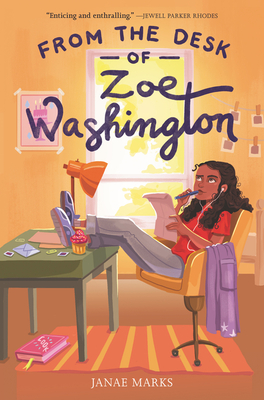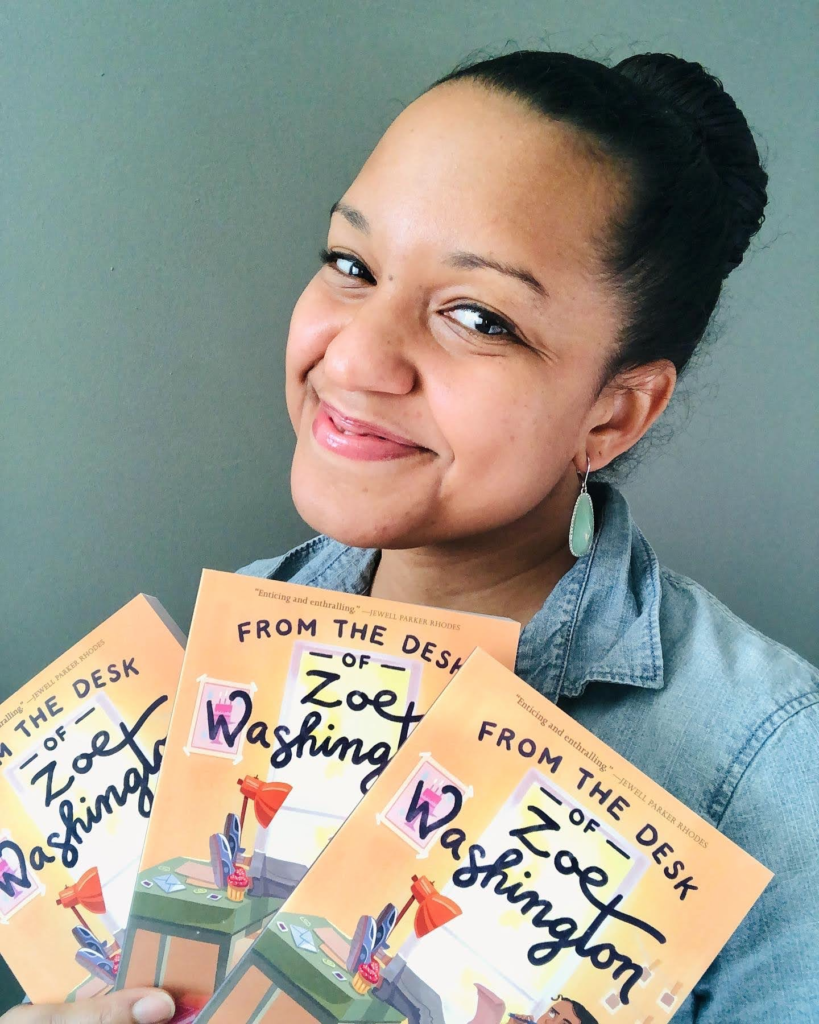craft post by Kristi Wright
Recently, KidLitCraft Editor, Anne-Marie Strohman, analyzed books with overarching story questions that show up right away in the first chapter. But is it possible to have one that takes its time to arrive in the story?
Remember, an overarching story question drives not just a scene or a chapter, but the majority of the novel. Wondering questions, on the other hand, are an excellent tool for piquing your readers’ curiosity. They need the answer and are willing to turn pages through a scene or even multiple scenes to get it.
In From the Desk of Zoe Washington, author Janae Marks uses some great techniques to slowly build up to her overarching story question without sacrificing tension. NOTE: While Marks uses subplots to great effect in driving page turns, in this post, we’re going to focus on the main plot.
There are spoilers embedded in this analysis, so please read Marks’ novel first!
STORY QUESTION REVEALED IN THE FLAP COPY
Flap copy is the text that goes on the flap of a dust jacket that tells potential readers what it’s about. This copy often reveals the overarching story question. At minimum, it hints at it. Here’s a portion of the copy for From the Desk of Zoe Washington:
What does a girl say to the father she’s never met, she hadn’t heard from until his letter arrived on her twelfth birthday, and who’s been in prison for a terrible crime?
A crime he says he never committed?
Could Marcus really be innocent? The truth is somewhere out there, and Zoe is determined to uncover it.

Anyone who reads the marketing copy for this book now knows the overarching story question: Will Zoe uncover the truth about whether her dad is innocent or guilty of the terrible crime he’s in prison for?
Potential readers will choose this book based on whether they’ve been hooked by this idea of a daughter who’s determined to discover the truth about her incarcerated dad. With the story question teed up, the reader already is primed to feel mounting tension until its actual reveal on the pages.
This question leads to another: If Zoe’s dad is innocent, will he be released from prison? We don’t see this question in the back copy because its existence depends on the answer to the first question. It only matters if Zoe is able to prove to her satisfaction that her dad is innocent. Readers can hope that he is, but they can’t be sure. And this secondary question doesn’t drive the narrative like the first one.
With the story question revealed in the flap copy, now the author can take her time to let the story unfold with a series of wondering questions that amp up the tension till we get to the big moment when Zoe’s dad tells her he’s innocent.
NOTE: Some people don’t read the flap copy before they start reading. Therefore, a novel must hold a reader’s interest without relying on any teasers. Marks’ techniques work to pique interest regardless of whether a potential reader has read marketing material about the novel.
FIRST SENTENCE HOOKS WITH INCITING INCIDENT
With an awesome opening sentence, Marks not only introduces the inciting incident, but creates a storm of wondering questions for the reader:
The day I turned twelve, I was certain it’d be my favorite birthday yet, but then I got the letter. (1)
Okay, as a reader, I’m hooked. What letter? Who sent it? Why did it ruin her birthday?
That letter incites everything that follows.
After that opening sentence, Marks zooms out to give us more details about what led up to that inciting moment. Which leads us to her next technique.
FIRST CHAPTER PACKED WITH WONDERING QUESTIONS FILLED WITH TENSION AND STAKES

After that fab first sentence, Marks steps back and introduces us to Zoe as a character. Through her description of her birthday party at a local bakery, we learn about Zoe’s obsession with baking. This is going to be a major thread for the story. As soon as we return to the letter, though, more wondering questions ensue!
I glanced at the return address and froze. “Massachusetts State Penitentiary” was typed on the upper left corner, across from a waving American flag stamp. The name Marcus Johnson was written in that same blue handwriting above the prison’s name.
It was a letter from my convict father, a man I’d never heard from before. I couldn’t believe it. (3)
Cue the wondering questions: What’s the deal with her father? Why hasn’t she heard from him before? Why’s he in prison?
Zoe continues with:
I wanted to read it, but I was also terrified of what it might say. He’d committed a terrible crime. What if he’d written something scary? (4)
Her thoughts amp up the tension by clarifying the stakes. Then we see Zoe’s wonderful mom morph into a potential antagonist:
It wouldn’t be a good idea to show Mom. I was pretty sure she’d take it away without letting me read it. (4)
Oh no! Why? What’s the deal with her mom? Reader tension mounts as Zoe’s mom acts super tense looking through the mail:
She smiled at me, but it was a forced smile, like she wasn’t actually happy. She picked up the pile of mail, and as she flipped through it, her shoulders slowly returned to their normal position. (5)
Does Zoe’s mom know there could be a letter from Marcus?
There’s so much packed into this first chapter with Zoe’s idyllic family life in sharp contrast to the big reveal that she has a biological dad in prison. Her mom acting super weird about the mail is icing on the “tension cupcake.”
The chapter ends with another question and an affirmation by Zoe:
What could Marcus have to say to me?
I had to know. (6)
So do the readers!
WONDERING QUESTIONS FRAUGHT WITH EMOTION UNTIL THE BIG STORY QUESTION IS REVEALED
We readers join Zoe as she works through her own emotions and confusion. She has questions, we have questions. In chapter two, she reads her biological father’s letter which seems to imply that he’s been writing for a long time:
Even if you never reply to these letters, I’ll keep writing them. (8)
Whoa! Why does he talk about letters and yet, she’s never gotten one? A mystery, for sure.
We get another big reveal on page 24 when Zoe is talking to another character:
“Your dad that’s in jail.” Trevor paused, and then said, “He’s there because he killed somebody, right? (24)
Finally readers know the magnitude of the crime Zoe’s father was convicted for. But it’s not till Chapter 11 that Marcus reveals the following in a letter:
I hoped you wouldn’t ask about this, because it opens up a can of worms. There’s no easy way to put this. I didn’t do it. I’m innocent. I have an alibi and there was even a witness, but I’m in here because my lawyer couldn’t prove that I didn’t do it. Even after we appealed my conviction. It’s unfair, but nothing can be done. (87)
Now the story kicks into high gear. At first, Zoe is disappointed and angry with Marcus. She cannot believe that someone would be in prison for so long if they were innocent. Therefore, Marcus must be lying.
It takes a few pages, for Zoe to ask the question:
What if Marcus was telling me the truth? He said he wouldn’t lie to me. Did innocent people end up in prison? (94)
She immediately assumes that’s impossible. It’s not until Chapter 13 that she attempts to research the idea of wrongful conviction. There she learns about an organization called The Innocence Project, that helps innocent people get out of prison.
Did this mean Marcus could be telling the truth? If that kind of organization existed, then innocent people must go to prison. I couldn’t believe it. (101)
Zoe’s confusion and internal debate come to a head in Chapter 15 when she commits to investigating whether her father is innocent or guilty:
I needed to know if Marcus was telling me the truth. If he was, I could keep writing to him and keep getting to know him. But if he was lying about this, then I couldn’t trust him. (121)
Now Zoe’s stakes are clear. She either has a relationship with her biological father or she doesn’t. From this point forward in the novel, Zoe takes more and more risks to uncover the truth of the murder that landed her father in prison.
Finally, the overarching story question is front and center: Will Zoe uncover the truth about whether her dad is innocent or guilty of the terrible crime he’s in prison for?
Later in the novel, when Zoe finally uncovers the truth, readers want to know if her dad will be released from prison. This is not the overarching question that drives the book, but it’s an important question to answer for reader satisfaction. And rest assured, it is answered!
As an author, you have lots of freedom over how you structure and pace your stories. Ultimately, you want to write a novel that will drive your readers to ask the types of questions that will keep them feverishly turning the page. How exactly you do that is up to you!
NOW IT’S YOUR TURN
- Where do you want your inciting incident to be revealed? Is there an opportunity to foreshadow it or even reveal it in the opening line of your novel?
- Does your story require a slow build from wondering question to wondering question until your overarching story question finally is revealed? If so, make those wondering questions count by filling them with tension and stakes.
- Don’t be afraid to let your character sit with her emotions as she debates what her course of action should be.
If you like this post, check out these other ones on story questions:
Also, this companion post that explores writing about tough subjects:
Kristi Wright (co-editor) writes picture books and middle grade novels. Her goal as a writer is to give children a sense of wonder, a hopefulness about humanity, and a belief in their future. She is represented by Kurestin Armada at Root Literary. She is an active volunteer for SCBWI and a 12 X 12 member. Find her at www.kristiwrightauthor.com and on Twitter @KristiWrite.


This is a really useful analysis about a book I really enjoyed! Thank you so much for sharing your thoughts. I’ll be looking for more and returning to this blog!
Hi Andrea:
Thank you so much, Andrea! I really enjoyed this book too:)
Best,
Kristi